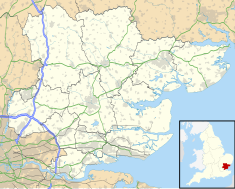| Shire Hall, Chelmsford | |
|---|---|
 | |
| Location | Chelmsford, Essex |
| Coordinates | 51°44′05″N 0°28′22″E / 51.7347°N 0.4729°E |
| Built | 1791 |
| Architect | John Johnson |
| Architectural style(s) | Classical style |
Listed Building – Grade II* | |
| Designated | 20 May 1949 |
| Reference no. | 1141328 |
The Shire Hall is a municipal facility in Tindal Square in Chelmsford, Essex. It is a Grade II* listed building.[1]
History
[edit]The current building was commissioned to replace an ageing 16th century sessions house at the north end of the High Street which hosted the quarter sessions and which had been supplemented by a smaller building which hosted the nisi prius court.[2]
The new building, which was designed by John Johnson in the classical style with a Portland stone façade, opened in July 1791.[1][3] The design involved a symmetrical main frontage with five bays facing onto Tindal Square; the central section of three bays, which projected slightly forward, featured three arched entrances on the ground floor which were originally open; there were three windows on the first floor interspersed with Ionic order columns supporting a large pediment containing a clock.[1] Above the first floor windows were carvings depicting justice, wisdom and mercy.[1] Internally, the principal rooms were a corn exchange and two court rooms on the ground floor and there was a large assembly room on the first floor.[4]
In 1856, after a crowd entered the building to attend a trial of five men charged with murder while poaching, the staircase collapsed killing one youth and seriously injuring four others.[5]
Elected county councils were established in 1889 under the Local Government Act 1888. Essex County Council held its first formal meeting at Shire Hall on 2 April 1889, when the question of where the council should meet was debated. It was eventually decided that the four quarterly meetings of the council would be held at Shire Hall, but other meetings and committees would be held in London, which was more accessible by train for the majority of the councillors.[6][7] Shire Hall continued to be used for quarterly meetings of the council until a new council chamber at County Hall was completed in 1938.[8]
Shire Hall's function as a judicial facility reduced with the opening of the new Crown Court in New Street in 1982[9] and ceased completely with the opening of a new magistrates' court in New Street in April 2012.[10] In 2019, after the building had lain empty for seven years, the county council appointed the developer, Aquila, to submit proposals for a mixed-used development in the building.[11][12]
Works of art in Shire Hall include three statues of classical female figures by the sculptor, John Bacon,[13] as well as chimney pieces at either end of the assembly hall containing panels carved by Charles Rossi.[14]
References
[edit]- ^ a b c d Historic England. "Shire Hall, Chelmsford (1141328)". National Heritage List for England. Retrieved 22 August 2019.
- ^ "Shire Hall: Past, present and future". Essex Record Office. 7 February 2013. Retrieved 7 October 2020.
- ^ Bettley, James; Pevsner, Nikolaus (2007). Essex (Pevsner Architectural Guides: Buildings of England). Yale University Press. p. 210. ISBN 978-0300116144.
- ^ "The Shire Hall, Chelmsford". Britain from above. Retrieved 7 October 2020.
- ^ Trial at the Shire Hall, The Essex Standard, 27 February 1856.
- ^ "Essex County Council: First statutory meeting". Chelmsford Chronicle. 5 April 1889. p. 6. Retrieved 12 June 2023.
- ^ "Conference on Labour History in Essex - Spring 2005" (PDF). Labour Heritage. p. 2. Archived from the original (PDF) on 17 August 2016. Retrieved 23 August 2019.
- ^ "The County Hall". Chelmsford Chronicle. 30 September 1938. p. 9. Retrieved 13 June 2023.
- ^ Mulcahy, Linda; Rowden, Emma (2019). The Democratic Courthouse: A Modern History of Design, Due Process and Dignity. Taylor and Francis. ISBN 978-0429558689.
- ^ "Shire Hall shuts as it loses its court role". Thisistotalessex.co.uk. 5 April 2012. Archived from the original on 13 September 2012. Retrieved 21 April 2012.
- ^ "Delays on plans for the Shire Hall blamed on art gallery proposal". Essex Live. 14 May 2019. Retrieved 14 November 2020.
- ^ "Plans for Chelmsford's Shire Hall due before end of 2020". Essex Live. 16 September 2020. Retrieved 14 November 2020.
- ^ Bacon, John. "Classical female figures". Art UK. Retrieved 7 October 2020.
- ^ Rossi, John Charles Felix. "Panel Representing Polyhymnia, Holding a Scroll, with a Caduceus". Art UK. Retrieved 7 October 2020.
